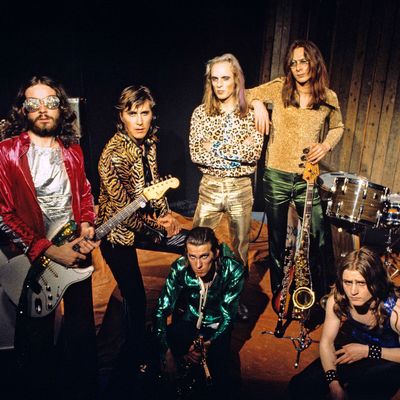
One of the most notable of the inductees into the Rock and Roll Hall of Fame this year is Roxy Music, the pioneering 1970s art-rock band. The band’s later pop phase — the albums Flesh and Blood and Avalon, the lovely ballad “More Than This,” sung with feeling by Bill Murray in Lost in Translation — is known to many; less clear is the band’s devilish and highly influential history. It’s one that spans a tumultuous decade in music and a dizzying evolution in the band itself, all due to the peculiar tastes and quixotic talents of its leader, Bryan Ferry.
Indeed, there are three formal phases to the band’s sound, demarked in two albums each, with a transitional album in between. Here’s a guide to understanding Roxy – the music, the legacy, and the band bickering – told through some key essential tracks.
“Re-Make/Re-Model” (1972)
We aptly begin with the leadoff track to their debut eponymous album — a clanking rush with discordant vocals, discordant sax, discordant guitars, discordant everything. The music here is plainly descended from the Velvet Underground, from the primitive chug of the production to the drone-y and distant vocals, but Ferry had bigger things in mind. Odd for the time, the title had no relation to the actual song, which has something to do with seeing a woman in a car. In the second half, wild synth buzzes and whines basically take over as lead instrument; from Ferry’s weird vocals to the electronics and crazy production to the absurdist touches — there’s even a half a cop of the Beatles’ “Day Tripper” riff — this could be a Pere Ubu track eight years later.
It was the time of the origins of glam (T. Rex and Bowie were on the prowl in the U.K.), and prog rock, too, with Pink Floyd and King Crimson already established. Roxy bridged those worlds — the band was hailed as the progressive rock act of the year by some magazines — but was interested in others as well, and had a sound that ranged from the elemental (it was arguably proto-punk) to the full-on freakout. Roxy were not virtuosos — anyone could hear that. But they did have haut pretensions, which stood there baldly amid their almost vulgar subject-matter. This was the high-low pastiche of capital P-A Pop Art, and Ferry was an adherent.
Who was Bryan Ferry exactly? It’s a difficult question, even so many years on. He is one of the most elusive and difficult figures in rock. To many he is an unflappable style icon — the epitome of controlled dissolute cool; to others, particularly those from the U.K. who can read class strivings well, the story is more complex. Ferry came from a very poor family in the far northeast of England, the rough equivalent of being from West Virginia in America. He grew up and out, of course, and ended up in art school in London at just the right time, along the way losing any trace of his northern accent. He wasn’t really a musician himself, but seemed to have some desire or instinct of how to create a band that would go where bands had not yet gone.
One by one he found people: a strong, highly competent drummer in Paul Thompson; an odd duck who insisted on playing oboe, Andy Mackay; a beginning guitarist with promise in Phil Manzanera; and, most importantly, a monstrous imp who was beginning to experiment with synthesizers and had a lot of contrarian ideas informed by Pop Art as well. His first name was Brian-with-an-i, and he would eventually become known by only his last name: Eno. (Somehow Roxy managed the trick of creating any number of great rock performances while never having a steady bassist.)
“Virginia Plain” (1972)
This is their first single. One reason Roxy’s first albums were and are hard to read in America is that the band was playing in a pop sandbox in the U.K. that was much different from the U.S. scene. The game was both to become a pop star and at the same time do it in some new and outrageous way. The most important aspect of Roxy was its postmodernism, putting it a step past Velvet Underground. Mackay’s keening horns were an unsubtle throwback to the blaring saxes of the first rock-and-roll records — remember that the music at this point was just 15 years on from “Rock Around the Clock” — but Ferry’s voice, a vibrato’ed roué’s croon, took things off in a different direction. The chugging guitar textures recalled the Velvet’s proto–art rock, but the blurting synthesizers were an entirely novel addition, suggesting a crude sci-fi overlay, but in a somewhat retro, Flash Gordon-y way. And over all this, Ferry was spouting some species of Pop Art slogans in a mannered, highly malleable voice.
Physically, the band was a mixture as well: Ferry sometimes dressed glam, but quickly evolved to sporting some upper-class costume, from tuxedos to riding breeches. He boasted the image of a matinee idol, but onstage was a bit ungainly and did not engage with the audience the way glam stars of the day generally did. (“A Dracula-type Presley,” as Ian Hunter once put it.) Eno, by contrast, dressed like a peacock who’d woken up in a drag queen’s boudoir after a rough night. Guitarist Manzanera played the role of a Flash Gordon villain with a pair of gigantic fly sunglasses on, while others in the band might be sporting ‘50s quiffs. It was high and low, but also futuristic and retro, glamorous and tarnished, artificial and yet organic. And again, back then, this was odd.
“Virginia Plain” was all of that, encapsulated in one song. It’s sneery (in an almost Dylanesque way), and punky, with some stream-of-consciousness lyrics from Ferry that seem to be about hitting the town, and then the world, with some sort of glamorous model. (Virginia Plain was a brand of cigarettes; the title figure might, in Ferry’s mind, be the model on the pack.) And throughout we hear insistent squeaks from the deranged horn section — a sound that would be appropriated by X-Ray Spex a few years on — amid pumping guitars.
“Do the Strand” (1973)
This was the leadoff track to the band’s second album, For Your Pleasure; for the second time, Ferry put a glamorous woman on the cover, which would become a Roxy trademark through its classic period. In this one, she is standing on a street, holding some sort of black jaguar on a leash. The album encompasses everything from blaring rock like this, to punky workouts like “Editions of You” to insane, almost ten-minute multi-part excursions like “The Bogus Man.” Ferry gets a little bit out of control at the end: “But it can’t beat Strand power / The Sphinx and Mona Lisa / Lolita and Guernica / Did the Strand.”
“In Every Dream Home a Heartache” (1973)
This was the most notorious and venturesome of the early Roxy tracks, something akin to the Velvets’ “Black Angel Death Song,” with Ferry daintily dispensing some spoken words over a background of dissonant strings and spooky synth noises. The impetus to the song was reportedly a massive collage done by one of Ferry’s art teachers, but it’s mostly remembered for the louche ending, which reveals that the singer’s dream home has an inflatable doll for a wife: “I blew up your body / But you blew up my mind.”
“Street Life” (1973)
There was a portentous element to that cover of For Your Pleasure. When the gatefold of the original LP was opened, you could see Ferry emerging from a limousine to meet the cover model and her jaguar. This not-so-subtle elevation of the singer irritated the other members of the band; it underscored the fact that this was Ferry’s operation and he (and his coterie of advisers and managers) was viewing the operation as a vehicle for his stardom. Standing in the way of this approach was Eno, who, ever quotable and dressed ever-more flamboyantly, was now a star in his own right at band shows and in the media.
Eno was also famous for a sexual appetite extravagant even by the rock-star standards of the day, and the attention he drew from women alienated Ferry, a huge part of whose image involved being the glamorous (and of course sexually desirable) frontman. The split of personalities might or might not have been inevitable, but, as the band’s biographer David Buckley told the tale, it got to the point where live shows were being disrupted by Eno’s vocal contingent in the crowd. Ferry had his manager ask Eno to leave the band, something of a dick move. There’s only room for one nonmusician in a band, Ferry is reputed to have said. (Post-Roxy, Eno recorded a few albums, considered classics in some circles; went on to create ambient music; and, of course, became one of the most important producers in rock over the next few decades, overseeing key works by everyone from Talking Heads to U2.)
Eddie Jobson stepped in on keyboard, and kept the band’s electronics challenging and forceful. Here, on “Street Life,” you still have the blaring horns and Ferry’s committed, extravagant vocals playing the part of some social animal charting the excitement in town. The chorus — just the title words, gruffly articulated, and seemingly electronically treated — was unlike anything that any other band was doing at the time, but was another top-ten hit for the band in the U.K. There’s a gay feint or two as well: “Hey good-looking boys gather round,” Ferry sang. That’s important: Roxy’s camp leanings — dating back to the model on their debut album’s cover, whose garish beauty suggested a drag queen— long made them catnip to gay listeners.
“A Song for Europe” (1973)
This is the track that, more than any other, set the band on the post–art-rock, commercial path to come. It’s worth noting that the music came from Andy Mackaye (who incidentally would provide similar duties on Roxy’s first U.S. hit, two albums to come). The pretense of aesthetic mixtures all in one song are gone. This over-the-top composition, without which the world of Morrissey cannot be conceived of, is Ferry’s first great emotional star-turn. He’s sitting in a café, reflecting morosely: “Though the world is my oyster / It is only a shell.” Aside from the title (a reference to the Eurovision song contest), there is no archness here, just full-on Grand Guignol excess complete with verses in French (!) and Latin (!!) at the end, and yet wholly convincing from start to finish. This torch song to end all torch songs was another touchstone for his gay following. Ten years after the release of Stranded, the song could still reduce willing listeners to tears.
“The Thrill of It All” (1974)
Country Life is the first of Roxy’s two classic period works, a pair of very solid rock albums that build on all of Ferry’s affected postures and construct solid song-cycles of intelligence, creativity and class. “The Thrill of It All” rocks convincingly — if, as always, archly — in a maelstrom of sound. What follows is a suit of disparate songs, with a heavy Germanic admixture that sounds positively Weillian here and there. “Casanova” is probably the least of these, but it is notable for its deflating ending: “Now you’re nothing but second hand in glove.” Most of the rest of the album toys with the same sort of decayed epicureanism: What can a poor boy do, Bryan Ferry was asking, but walk out in style?
“Love Is the Drug” (1975)
The leadoff track and single from Siren, the band’s fifth album, this song made it into the bottom reaches of the U.S. top 40, but its legend and influence were much greater. This undeniable semi-novelty hit had a jittery bass beat, a canny piece of dance manqué; the taut instrumentation and the slightly mechanical tale the narrator is telling would be a marked influence on the Talking Heads albums that would appear just two years later. There’s an alluring beginning — footsteps, a car door opening, an engine starting up — together an irresistible entrée into a rhumba’d head-snapping beat that marries art rock to disco.
The track and the rest of the accompanying album are Roxy at its height. The songs here start out with a bang, a whoosh, or a sweeping fanfare. The sound is mature, wild when it has to be, but restrained in a way Roxy had never been before. The Germanic conceits that marked Country Life are replaced by pastoral passages in songs like “End of the Line.” Instead, Ferry’s most powerful suite of songs contains lush inquiries into the nature of decadence, epicureanism, hedonism, and their discontents. And “Both Ends Burning” defines the mature use of synthesizers during this time.
“Dance Away” (1979)
Four years went by between Siren and their sixth album, Manifesto, as Ferry pursued a solo career, though why he felt he needed to was never clear. Roxy was always his band. But his solo work was just commercially persuasive enough for him not to abandon it. (He offered various albums of crooned covers — and some pretty credible singer-songwriting; The Bride Stripped Bare, notably — some of which occasionally did well on the charts.) Meanwhile, the cover imagery of these albums presented him as ever more a sophisticate — posing in a tux in front of a luxurious pool on Another Time, Another Place, for example.
Ferry’s de-postmodernized glamour image had the effect of making him something close to tabloid fodder in the U.K. His first star relationship was with Jerry Hall — that’s her on the cover of Siren in the blue quasi-mermaid getup. But the glamorous model who remained in touch with her raucous Texan roots eventually soured on the glamorous rock star who’d done his best to forget his poor northern upbringing; Hall ultimately ran off with Mick Jagger.
All of this, of course, lacked the Roxy archness, and undermined Ferry’s credibility in certain hep U.K. rock circles, and looked ever more foolish after the rise of punk. In any case, he never became the international star he wanted to be. He went back to Roxy Music and in effect merged his two careers and — finally — would eventually go platinum in the U.S.
“Dance Away,” a simple tale of regret, is the key transitional moment to Roxy’s final phase, and the standout track on the understated and somewhat disappointing Manifesto, the album that ushered that final phase in. It begins with blocks, giving it a slight Latin feel; the verses are spacious, almost rambling; but when the chorus slams in you can see it’s Ferry’s most beautiful melody, and most powerful ballad, to that point — and may also include his best lyric, too: “She’s dressed to kill / And guess who’s dying?”
“In the Midnight Hour” (1980)
In his solo career, Ferry recorded lots of covers; Roxy never did. But on Flesh and Blood, which came out right on the heels of Manifesto and was the first of the two albums in Roxy’s final phase, you can see the intent of the band had changed with the inclusion of this cover of the Wilson Pickett hit and the Byrds’ “Eight Miles High.” It’s not bad — it’s tasteful, warm, and a lot better than most of Ferry’s solo covers — but why was Roxy recording covers?
Ferry was plainly watching the music scene change quickly. While some of the doctrinaire in Britain had tired of Ferry’s aristocratic posturings, he, like Bowie and not too many others of the ‘70s old guard, had somehow escaped a lot of punk’s derision. The musicians in the Sex Pistols were Roxy Music fans. New Wave bands like Devo, Talking Heads, and Blondie often sounded like Roxy. And to the up-and-coming New Romantics — bands like Spandau Ballet and Culture Club and Duran Duran, who would soon be selling millions around the globe — Bryan Ferry and Roxy Music were cultural touchstones. (Members of the latter will be introducing Roxy at the Hall of Fame induction ceremony this week.) And of course Roxy was there in the angularity of Gary Numan, the jarring postmodern affects of the Cars, the reckless artifice of Madonna, and on and on.
And so by the time Ferry came back for Roxy’s final phase, he had a credibility that somehow made his sheer pop excursions credible, too. Fans somehow intuited that, while the emotions in the song were genuine (and sometimes cut to the bone), this was really just a final species of posture.
“Oh Yeah” (1980)
Flesh and Blood’s two original radio hits were “Over You,” a bouncy keyboard-‘n’-horns–driven track, and this wisp of pop mythology, in which a song called “Oh Yeah” marks the singer’s psyche after a breakup. Ferry had never sounded so aching, and his melodies had never been so broadly accessible. And yet somehow there’s something not quite human about him. Check out this TV performance of “Oh Yeah” with Ferry in full Dracula-Presley mode: Ferry, who is supposed to be a remarkably handsome and suave guy, looks like a mannequin, his movements mechanical and not so much ill-at-ease as nonhuman, his smile a grimace, his emotions received.
The album version, of course, stands on its own. Roxy was always a difficult band to produce — how to record artifice is a rabbit hole many could have lost themselves in. On the band’s last two albums, Ferry brought in Rhett Davies, who had been recording his solo albums for years and had worked on Eno’s first solo records as well. The sound here was as far from art rock as one could imagine. It was a high global pop in which all the instruments, the backup singers, and even the singer himself are all carefully produced parts in a highly sophisticated pop sheen.
“More Than This” (1982)
And finally, came Avalon, the pop masterpiece that erases all memories of the original Roxy sound. It’s basically an MOR record, all tasteful keyboard washes, dulcet sax solos, and anything else Davies and Ferry can conjure up. Ferry is still wild — like the jolting melody lines in “To Turn You On” — but he’s operating now in a very controlled, overdetermined environment, with even the lyrics carefully sculpted, abstract to the point of almost meaninglessness: “Would you have me dancing out of nowhere?” Ferry sings at one point. The beats, over and over again, are vaguely Latin, or simulacrums of Latin. The peculiarities of Ferry’s voice are gone as well; he is now a perfectly mature pop singer, sharing with us intimations of helplessness: “When things go wrong / I do anything to turn you on.” And yet almost every song on this record is a melodic and production gem, an Old Romantic masterpiece in a New Romantic era produced and engineered to a T. The record was never actually a hit in the U.S., but it somehow insinuated its way into a generation’s consciousness and went platinum.
The first song on Avalon is “More Than This” — and, tell me, how many artists record their best song on their final album? The very first chiming guitars shiver with potent; the first line of melody fulfills that promise, and what might be Ferry’s most convincing vocal carried emotional reverberations in every line. What “this” is, that’s never explained of course. It’s a moment of longing or consummation too exquisite for words.
This turned out to be the end of Roxy Music. Ferry has recorded as a solo artist consistently since then, bringing the band back together occasionally in the last ten or twelve years to cash in on foreign tours or the lucrative festival circuit. (They were rumored to reunite, Eno included, at their Rock Hall induction, but the band have since confirmed that both Eno and Thompson will not attend.)
Roxy Music may have been many things, at many times, but principally, they were an art band. What did that mean? It meant that Ferry, particularly, tried to bring some of the aesthetics of Pop Art to rock. When you see a video of Roxy from their earliest period today, they look a little weird, and the sound is weird too — an amalgam of styles. But just as Warhol was taking banal objects and calling them art, so too was Ferry. He was pulling pieces of rock history — the ducktail haircuts of rockabilly, the burgeoning flash of glam, the svelte tuxedoed frontmen from classic Hollywood film, the blaring sax of the earliest rock as it evolved out of jazz, the found sounds emanating from the mellotron and those new synthesizers — and melding them together with a mix-and-don’t-match sensibility.
The trick, of course, was to do all that and find yourself a place in the pop firmament of the time, and in this way he was one of the lucky ones. Roxy didn’t spend years bonding and touring and painstakingly creating a sound; they were thrown together on a whim, with certain sidemen coming and going. There were always some Roxy doubters in the fickle U.K. music press corps, but a few friends made them a subject of hype even before their first record came out, and, in the U.K. at least, they were from the start the band of the moment boasting hit after hit for quite a while — and in terms of glam and art influence remain in the British mind second only behind Bowie.




